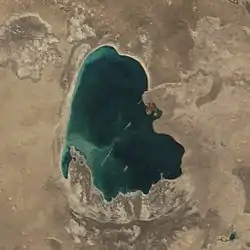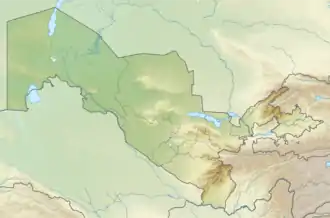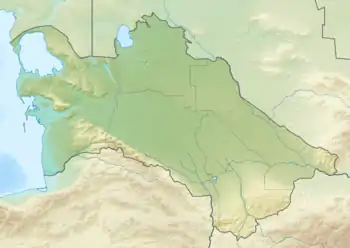Sarygamysh Lake
The Sarygamysh Lake, also Sarykamysh or Sary-Kamysh (Turkmen: Sarygamyş köli, Uzbek: Sariqamish ko‘li, Russian: Сарыкамы́шское озеро), is a lake in Central Asia. It is about midway between the Caspian Sea and the Aral Sea. The northern quarter of the lake is in Uzbekistan and the rest Turkmenistan.
| Sarygamysh Lake | |
|---|---|
 December 2001 | |
 Sarygamysh Lake  Sarygamysh Lake | |
| Coordinates | 42°00′N 57°20′E |
| Basin countries | Turkmenistan and Uzbekistan |
| Max. length | 125 km (78 mi) |
| Max. width | 90 km (56 mi) |
| Surface area | 3,955 km2 (1,527 sq mi)[1] |
| Average depth | 8 m (26 ft) |
| Max. depth | 40 m (130 ft) |
| Water volume | 68.56 km3 (55,580,000 acre⋅ft)[1] |
| Surface elevation | 5 m (16 ft) |
Up until the 17th century, the lake was fed by the Uzboy River, a distributary of the Amu Darya River, which continued on to the Caspian Sea. Today, its main source of water is a canal from the Amu Darya but also the runoff water from surrounding irrigated lands, containing high levels of pesticides, herbicides and heavy metals.
Contribution to the drying up of the Aral Sea
This and many other "unintended" lakes, such as Aydar Lake on the Syr Darya deny the Aral Sea about 150 cubic kilometers of annual inflow of water, directly contributing to, if not actually causing, the latter's drying up.
Etymology
The name of the lake comes from Turkic Sari (yellow) and Qamish (depression), a reference to the yellow color of silt and salt in the old dried up basin before its flooding by the Soviets. The modern Turkmen authorities wish to "Turkmenize" the name by contending that the name is Turkmen sarykamysh 'yellow reed'.[2]
The Turkmen section of the lake and the land around it is protected by the Sarygamyş Sanctuary.
History
Throughout its history, the lake has disappeared several times and re-emerged, depending on the arrival of the Amudarya waters. The drying out periods of the Sarygamysh lake were associated with the confluence of the river into the Aral Sea. The lake existed at the end of the Neogene period, in the upper anthropogene[3] (at 58 m above sea level), when its area covered, including the modern Assake-Audan basin,[4] and then in the 14th - 16th centuries AD (at the level of 50–62 metres above sea level).[3] It was first discovered and charted by the Russian geographer, Nikolai Petrusevich, in 1876.[5] The last time the waters of the Amu Darya directly entered the basin was during the flood of 1878.[3][6]
Since the beginning of the 1960s, the Sarykamysh lake has been filled with collector-drainage waters,[7] feeding was carried out through the Daryalyk collector, while water from the farmland of the left bank of the Amu Darya was used.[7][8]
Gallery
 Sarykamysh Lake at lower left, Oxus delta and what is left of the Aral Sea
Sarykamysh Lake at lower left, Oxus delta and what is left of the Aral Sea Sarygamysh Lake, from Uzbekistan
Sarygamysh Lake, from Uzbekistan Sunset at Sarygamysh Lake
Sunset at Sarygamysh Lake Political Map of the bipartite southern Aral Sea and this lake shared by one of those nations (Uzbekistan) and another.
Political Map of the bipartite southern Aral Sea and this lake shared by one of those nations (Uzbekistan) and another.
References
- Orlovsky, Leah; Matsrafi, Offir; Orlovsky, Nikolai; Kouznetsov, Michael (2014). "Sarykamysh Lake: Collector of Drainage Water – the Past, the Present, and the Future". The Turkmen Lake Altyn Asyr and Water Resources in Turkmenistan. The Handbook of Environmental Chemistry. 28. Berlin/Heidelberg: Springer-Verlag. pp. 107–140. doi:10.1007/698_2012_191. ISBN 978-3-642-38606-0.
- E.M. Pospelov, Geograficheskiye nazvaniya mira (Moscow, 1998), p. 369.
- Сариқамиш сойлиги — Template:Книга:НЭУ
- http://bse.sci-lib.com/article076978.html Ассаке-Аудан
- Igor S. Zonn; Michael H. Glantz; Andrey G. Kostianoy; Aleksey N. Kosarev (2009). The Aral Sea Encyclopedia. Springer Science & Business Media. p. 251. doi:10.1007/978-3-540-85088-5. ISBN 978-3-540-85088-5.
- Шнитников А. В. (1969). "Внутривековая изменчивость компонентов общей увлажненности". Ленинград: Издательство «Наука». Ленинградское отделение: 130. Cite journal requires
|journal=(help) - Григорович Н. (1977). "Солнце и вода, земля и соль" (8) (Наука и жизнь ed.): 68–69. Cite journal requires
|journal=(help) - "Сары-Камыш" (Словарь современных географических названий ed.). Екатеринбург: У-Фактория. Под общей редакцией акад. В. М. Котлякова. 2006. Cite journal requires
|journal=(help)
External links
 Media related to Sarygamysh Lake at Wikimedia Commons
Media related to Sarygamysh Lake at Wikimedia Commons